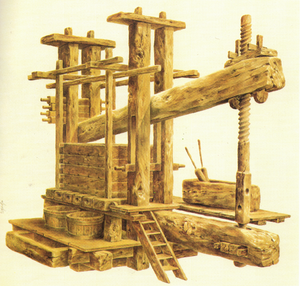Llagar
A llagar can be one of several things in Asturias:
- a machine for pressing cider
- a building or space that is used for making cider
- a collection of equipment for making cider
- a company that makes cider[1]
For our purposes, we will examine two of these; the home cider press space (llagar de casería) and the industrial companies that make cider commercially.
The Home Llagar
In a traditional casería there was almost always a llagar - a bodega for the making and storing of cider. The size and quality of the space and its implements determined by the size of the pumarada the caserío had, or the relative ingenuity of the owner. As the traditional farmstead practiced (as much as possible) a policy of autarky, the ability to produce one's own alcoholic beverage was just as important as the ability to produce one's own bread.
Ideally, the home llagar was situated facing north, was well ventilated, and dug into a hill to help keep it as cool as possible. It was build as large as practicable, in order to have sufficient room to work, and additional room to store multiple barrels and stacks of bottles of cider.
Inside this room would be an area or machine for chopping up apples, a press for extracting the juice, buckets and containers for catching the juice, and various barrels for fermenting the cider, as well as sufficient bottles for getting the family through the year.
Commercial Llagares
On the other end of the scale from the llagar de caserío is the commercial llagar - the cider mills that produce the millions of bottles of cider Asturians drink a year. Arising in the late 19th century, these commercial llagares have consolidated over time into a smaller and smaller number of larger and larger concerns. In 1958 there were 70 commercial llagares making sidra natural in Asturias. By 1980 that number was just 216, and in 1989 it had shrunk further to 134.[1] Currently, by my own count, there are roughly 125 commercial llagares in Asturias.
As I visit them, I will add specific articles about each of them below
Operating Llagares
- Acebal
- Agreco
- Alonso
- Angones
- Arbesu
- Arce
- Arsenio
- Basilio
- Benjamín
- Bernueces
- Breceña
- Buznego
- Cabañón
- Cabueñes
- Canal
- Cañón
- Casa Pin
- Caseria San Juan Del Obispo
- Castañón
- Contrueces
- Coro
- Cortina
- Corzo
- Crespo
- Cueto
- d'Asiegu
- El Cerezo
- El Cuchareru
- El Duerno
- El Duque
- El Fugitivo
- El Gaitero
- El Gobernador
- El Güelu
- El Llagar de Castiello
- El Mariñan
- El Noceu
- El Piloñu
- El Torneru
- El Traviesu
- Estrada
- Fanjul
- Fano
- Fonciello
- Foncueva
- Fran
- Frutos
- Gelo
- Germán
- Guimarán
- Herminio
- Huerces
- J. Tomas
- JR
- Juanin
- L'Argayon
- La Llarada
- La Morena
- La Pipa
- La Rionda
- Llagar de Pin
- Llagar la Morena
- Los Angones
- Los Bayones
- Los Gemelos
- M. Busto
- M. Zapatero
- Martinez
- Mayador
- Menéndez
- Mestes Nando
- Miranda
- Muñiz
- Orizon
- P. Roces
- Panizales
- Peñón
- Piñera
- Quelo
- Riera
- Riestra
- Rio Aliso
- Roza
- Sampedro
- Sanchez
- Segundo
- Sirviella
- Solliero
- Tomás
- Torre
- Trabanco
- Tuero
- Valleoscuro
- Vallina
- Valverán
- Vigón
- Villanueva
- Viñao
- Viuda de Angelón
- Viuda de Corsino
- Viuda de Palacio
